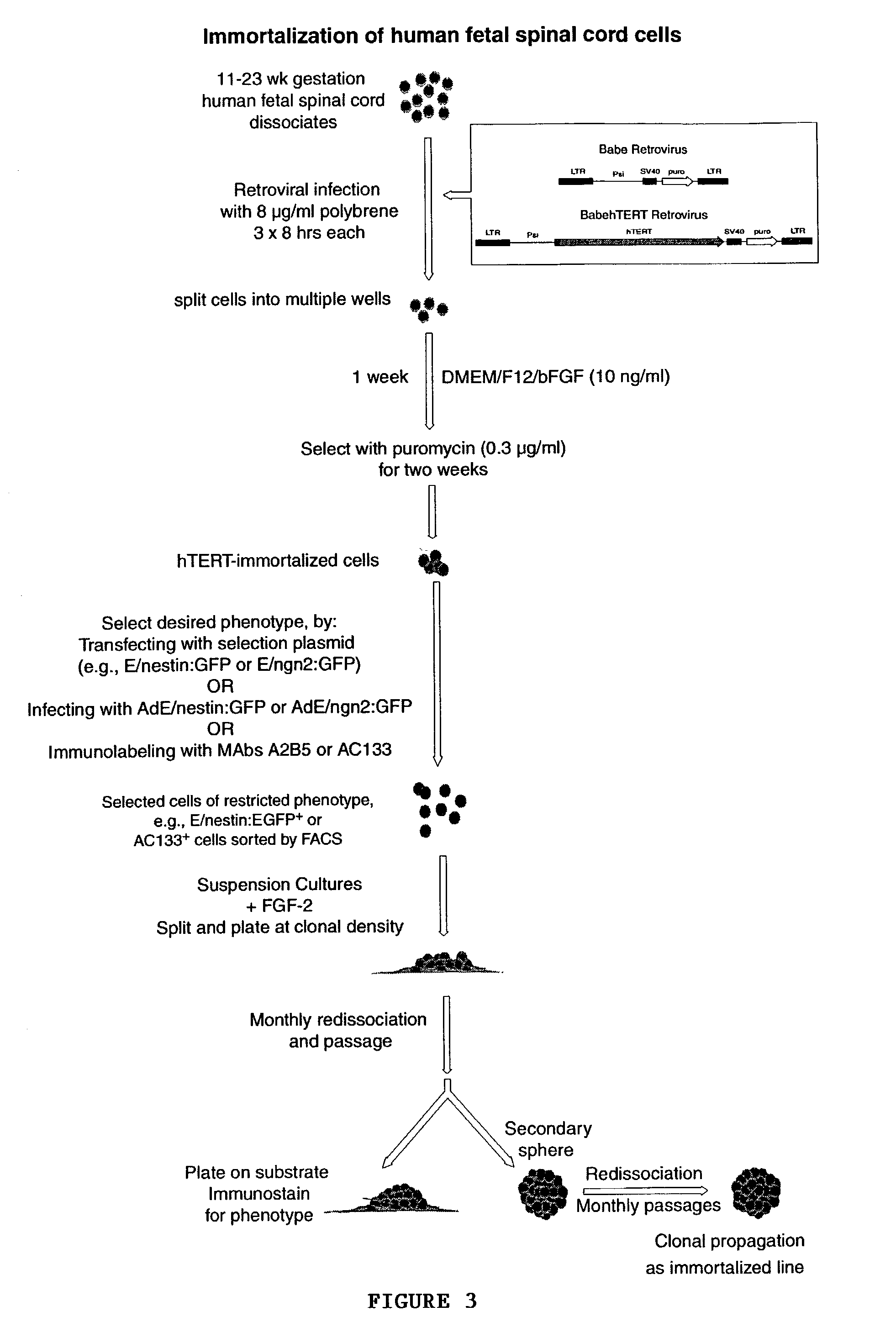Telomerase immortalized neural progenitor cells
a neural stem and progenitor cell technology, applied in the field of telomerase immortalized neural stem and progenitor cells, can solve the problems of reduced enzymatic dissociation and purification efficiency, reduced enzymatic activity, and limited clinical utility of damaged brains, and achieves little expansion capacity in vitro.
- Summary
- Abstract
- Description
- Claims
- Application Information
AI Technical Summary
Benefits of technology
Problems solved by technology
Method used
Image
Examples
example 1
Spinal Cord Preparation and Culture
[0057]Normal human fetal spinal cords were obtained in the course of elective abortions. Cervical, thoracic and lumbar regions of the spinal cord were dissected out in Ca2+ / Mg2+-free HBSS. For later fetuses (11 and 13 week g.a.), the spinal cord was divided longitudinally into ventral and rostral strips before rostrocaudal segmentation. Whereas the spinal neuroepithelium was used as the source of progenitors in the 13 and 18 week g.a. samples, the entire thickness of the cord was used in the 9 and 11 week samples, which proved too small for selective removal of the neuroepithelium. The dissected tissue was minced, suspended in PIPES buffer (in mM: 120 NaCl, 5 KCl, 25 glucose, and 20 PIPES), then digested in papain—PIPES (11.4 U / ml papain; Worthington, Freehold, N.J.) and DNase I (10 U / ml; Sigma, St. Louis, Mo.) for 40 min while shaking at 37° C. The cells were collected by centrifugation at 200×g in an IEC Centra-4B centrifuge, resuspended in DMEM / ...
example 2
Retroviral hTERT Propagation and Infection
[0058]For immortalization, cells were infected with VSVg-pseudotyped retrovirus encoding hTERT in pBABE-puro under CMV control. Equal number of cells from each tissue sample were also infected with control retrovirus with the vector pBABE-puro without hTERT. This served as an internal control to differentiate against any native non-immortalized progenitors. The cells were treated with the viral supernatants thrice at 8-hourly intervals with polybrene (8 μg / ml). Following viral infection, the cells will be resuspended in fresh medium and redistributed at lower densities to decrease to possibility of multiple transfectants in same culture dish.
example 3
Selection
[0059]One-two weeks after the viral infection, positively transduced cells were selected in 0.4 μg / ml puromycin (Sigma) for 2 weeks. Successful selectants from both retroviral pBabe:puro and pBabe:hTERT-puro infected cells were isolated and propagated in DMEM / F12 / N1 supplemented with bFGF (10 ng / ml, Sigma).
PUM
| Property | Measurement | Unit |
|---|---|---|
| Surface | aaaaa | aaaaa |
| Fluorescence | aaaaa | aaaaa |
Abstract
Description
Claims
Application Information
 Login to View More
Login to View More - R&D
- Intellectual Property
- Life Sciences
- Materials
- Tech Scout
- Unparalleled Data Quality
- Higher Quality Content
- 60% Fewer Hallucinations
Browse by: Latest US Patents, China's latest patents, Technical Efficacy Thesaurus, Application Domain, Technology Topic, Popular Technical Reports.
© 2025 PatSnap. All rights reserved.Legal|Privacy policy|Modern Slavery Act Transparency Statement|Sitemap|About US| Contact US: help@patsnap.com



